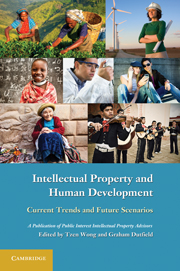Book contents
- Frontmatter
- Contents
- Boxes
- Contributors
- Foreword
- Preface
- Acknowledgements
- Acronyms and abbreviations
- Overview
- 1 Intellectual property through the lens of human development
- 2 Intellectual property and medicine: Towards global health equity
- 3 Food security and intellectual property rights: Finding the linkages
- 4 Trends and scenarios in the legal protection of traditional knowledge
- 5 Traditional cultural expressions: Preservation and innovation
- 6 Copyright and capability for education: An approach ‘from below’
- 7 Knowledge and education: Pro-access implications of new technologies
- 8 Cultural diversity and the arts: Contemporary challenges for copyright law
- 9 Scenario planning on the future of intellectual property: Literature review and implications for human development
- Appendix A Capability, opulence and utility1
- Appendix B Exploring alternative, collaborative models of innovation for medicines and vaccines1
- Appendix C Strategies and laws to promote traditional medicinal knowledge1
- Appendix D Educational use exceptions to copyright: A comparison among selected jurisdictions1
- Appendix E Copyright and contemporary art: A case study
- Index
- References
5 - Traditional cultural expressions: Preservation and innovation
Published online by Cambridge University Press: 05 June 2012
- Frontmatter
- Contents
- Boxes
- Contributors
- Foreword
- Preface
- Acknowledgements
- Acronyms and abbreviations
- Overview
- 1 Intellectual property through the lens of human development
- 2 Intellectual property and medicine: Towards global health equity
- 3 Food security and intellectual property rights: Finding the linkages
- 4 Trends and scenarios in the legal protection of traditional knowledge
- 5 Traditional cultural expressions: Preservation and innovation
- 6 Copyright and capability for education: An approach ‘from below’
- 7 Knowledge and education: Pro-access implications of new technologies
- 8 Cultural diversity and the arts: Contemporary challenges for copyright law
- 9 Scenario planning on the future of intellectual property: Literature review and implications for human development
- Appendix A Capability, opulence and utility1
- Appendix B Exploring alternative, collaborative models of innovation for medicines and vaccines1
- Appendix C Strategies and laws to promote traditional medicinal knowledge1
- Appendix D Educational use exceptions to copyright: A comparison among selected jurisdictions1
- Appendix E Copyright and contemporary art: A case study
- Index
- References
Summary
Introduction
This chapter addresses challenges faced by indigenous peoples and local communities in the legal protection of their traditional cultural expressions (TCEs). It also highlights considerations for governments, public institutions and non-profit organizations in attempts to promote TCEs to support indigenous peoples and local communities in their cultural, economic and social development. While TCEs are embraced within the broad, holistic approach to traditional knowledge (TK) adopted in this book, there are legal issues and developments specific to the protection of TCEs which merit separate analysis from those elements of TK addressed in Chapter 4. This chapter first explores some relevant concepts towards understanding the overlap between intellectual property rights (IPRs) and the protection of TCEs. It poses questions relating to the commodification of TCEs by IPRs, and how this potentially transforms the social relations underpinning creative processes in indigenous communities. At the same time, it is recognized that the making and marketing of some forms of TCEs present potential sources of livelihoods to many indigenous communities currently marginalized in the socio-economic order. Given a global environment where TCEs are increasingly copied and commercially mass-produced by third parties, some options and limitations in relation to intellectual property (IP) protection of TCEs are discussed, along with sui generis protection. While the Latin term sui generis means ‘unique’ or ‘of its own kind’, it remains to be seen how far these hybrid solutions ultimately depart from typical concepts in IP law. Beyond legal measures, there are indigenous protocols and other standards governing third-party access to and use of TCEs, including those evolving within the context of the Internet. These are also explored briefly in this chapter.
Concepts and definitions
According to Article 1(a) of the Revised Draft Provisions for the Protection of Traditional Cultural Expressions/Expressions of Folklore being reviewed at WIPO (‘WIPO Revised Provisions’), ‘traditional cultural expressions’ or ‘expressions of folklore’ are ‘any forms, whether tangible and intangible, in which traditional culture and knowledge are expressed, appear or are manifested’, and comprise the following forms of expressions (or combinations thereof):
verbal expressions, such as: stories, epics, legends, poetry, riddles and other narratives; words, signs, names, and symbols;
musical expressions, such as songs and instrumental music;
expressions by action, such as dances, plays, ceremonies, rituals and other performances, whether or not reduced to a material form; and
tangible expressions, such as productions of art, in particular, drawings, designs, paintings (including body-painting), carvings, sculptures, pottery, terracotta, mosaic, woodwork, metalware, jewelry, baskets, needlework, textiles, glassware, carpets, costumes; handicrafts; musical instruments; and architectural forms…
- Type
- Chapter
- Information
- Intellectual Property and Human DevelopmentCurrent Trends and Future Scenarios, pp. 175 - 217Publisher: Cambridge University PressPrint publication year: 2010
References
- 4
- Cited by

